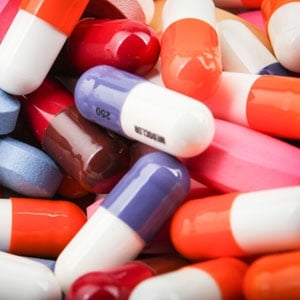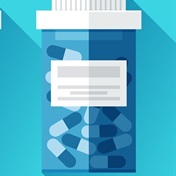
Counterfeit medicines are one of the world’s largest and fastest growing industries, ranking first among the list of counterfeit products in 2011.
Recent studies suggest that counterfeit drug sales have increased more than 90 percent between 2005 and 2010, creating revenue of more than R746 trillion.
One in 10 drugs around the world is counterfeit, and this statistic can reach seven in 10 in developing countries. However, the majority of the world’s population seems not worry about the possibility that they might be buying fake medicine.
Read: Up to 30% of all medcines in Africa are fake
Devoid of active ingredients
Counterfeit medicines are a serious danger to a consumer’s health, and patients can face a number of risks after consuming them.
They can contain an inadequate amount of active ingredients, and are sometimes completely devoid of any active ingredients, which can cause major adverse effects and complications for a consumer.
If a drug contains too low of a dose of active ingredients, not all bacteria, parasites and viruses are killed. These pathogens can therefore become resistant, allowing them to multiply and spread, causing consumers to either die or grow much sicker.
Counterfeit drug sales in the Ivory Coast
People get around Adjame's market on April 17, 2014 in Abidjan's working-class neighbourhood of Adjame where an area is reserved for the trade of counterfeit and diverted medicines from public hospitals. Photo credit: ISSOUF SANOGO/AFP/Getty Images
Sometimes, counterfeit drugs can contain a number of harmful or poisonous chemicals, such as boric acid, floor polish, nickel, leaded highway paint, heavy metals, brick dust and arsenic, to name a few.
In November 2008, 34 Nigerian children, aged four months to three years, died and more than 50 were hospitalized with severe kidney damage after their mothers, wishing to alleviate their children’s teething pains, unknowingly gave them a counterfeit drug.
The drug given to these children was "My Pikin Baby Teething Mixture", which translates to "my child" in local jargon. The medicine, in the form of syrup, was intended to soothe infant teething pains, but the fake mixture contained a deadly mix of diethylene glycol, more commonly known as anti-freeze, which is often used in fridges and cars.
When the babies consumed this highly toxic liquid that resembled glycerine, they reacted immediately. Those who did not die from the poison instead showed a number of symptoms, such as vomiting, kidney failure, diarrhoea, central nervous system damage and liver damage.
Counterfeit drugs in China
This picture below was taken on March 14 2013 and shows a Chinese policeman walking across a pile of fake medicines seized in Beijing and which were later destroyed. The rapid growth of Internet commerce has led to an explosion of counterfeit drugs sold around the world, with China the biggest source of fake medicines, pharmaceutical experts said as the illicit trade is now believed to be worth around 75 billion USD globally, with criminal gangs increasingly using the web to move their products across borders. Photo credit: STR/AFP/Getty Images)
Fake medicines are just like the real thing
Many counterfeit medicines are intentionally created to resemble authentic medicine. Oftentimes, a box or tube of counterfeit medicine can look exactly like the real thing. Counterfeiters are becoming better and better at replicating authentic medicine correctly; ordinarily, there is little to no way to tell if a pill is fake before, and sometimes after, consuming it.
However, the best way for consumers to identify potential counterfeits is to look for altered or unsealed containers, faulty spelling or packaging, font size, and tablet size or colour.
It is also important to be as familiar as possible with the medicine you regularly take. When a drug doesn’t taste right or if you have different side effects than what you are accustomed to, be suspicious.
You can reduce your risk of buying counterfeit drugs by purchasing them directly from your primary health care provider or from reputable pharmacies, though they may sometimes sell counterfeit medicine without even realising it.
Read: Counterfeit medicine trade targets Africa's poor
How the trade works
Medicine is frequently transported from authorised distributors to middlemen or wholesalers who sell drugs to one another. During transport, counterfeit drugs from foreign countries can enter the medicine supply chain.
A large chunk of the world’s counterfeit medicines originate in Asia. In fact, in 2011, China and India alone accounted for more than 20 percent of Africa’s pharmaceutical imports; with a manufacturing capacity less than 30 percent, much of the continent’s drugs are imported.
In 2008, 80 percent of the medicines used to treat HIV in Africa were imported, and 90 percent of all medicines available in sub-Saharan African countries were imported.
China accounts for one of the biggest shares of the trade in counterfeit medicines. In 2011, it was reported that Chinese authorities had closed down more than 1,300 medicine factories while investigating 480,000 cases of counterfeit drugs worth R607 million.
Most Chinese counterfeit medicines that find their way into Africa’s medicine supply chains first pass through Hong Kong and Shenzhen ports.
Illustration showing large counterfeit medicine seizures from The Wall Street Journal
The counterfeit drug trade in Africa
The flow of counterfeit medicine into Africa has increased drastically. A report done by the International Policy Network estimated that about 700,000 deaths a year might be prevented if patients were treated with real malaria and tuberculosis drugs, instead of counterfeit ones.
Read: New toolmay detect fake malaria drugs
Deaths due to counterfeit medicines have been a problem for years. In 1996, during a meningitis outbreak in Nigeria, 60,000 people were treated with counterfeit medicine, resulting in 2,500 deaths.
Read: Prescription meds online
There are several reasons why counterfeit drugs have become a common occurrence.
For one thing, criminal penalties for pharmaceutical counterfeiting tend to be far lower than for trafficking narcotics, such as heroin or cocaine. Additionally, the regulation of drug sale and quality in some countries tends to be extremely poor.
Moreover, many rural areas have few hospitals or clinics, and the ones they do have often have irregular hours of operation. Therefore, many of these citizens end up buying drugs at non-regulated markets or from street vendors, both of whom are more likely to sell counterfeits.
The proliferation of online medicine vendors
Lastly, counterfeit drugs are often sold at a cheaper rate than genuine medicine, which is an appealing factor to those who wish to save money. Remember, if the cost of a medicine seems too good to be true, it probably is.
Read: Fake online drugs a health risk
A packet of Pfizer Inc. Lipitor pills, left, sits next to a counterfeit product in this arranged photograph taken in Karachi, Pakistan. The trade of fake medications killed 107 heart patients by pills tainted with lethal amounts of an anti-malarial agent. Photographer: Asim Hafeez/Bloomberg via Getty Images.
Medicines purchased online are another major source of counterfeit medicines. Like those seeking a deal from medicine sold at markets, medicine purchased online can often be purchased cheaply.
Though there are some internet sites that sell medicine legitimately, there are also some that sell medicine illegally and without a prescription.
Over the years, hundreds of countries have collaborated with INTERPOL’s Operation Pangea, international weeks of action, to combat against the sale of illegal medicines online.
In the latest operation, Pangea VII, 111 countries participated, seizing 9.4 million fake and illicit medicines, making 239 arrests, removing 19,000 advertisements for illicit pharmaceuticals on social media sites, and shutting down more than 10,600 websites.
Read more:
Drug prices still beyond the poor
Online gangs sell fake H1N1 drugs
Fake cancer drug seller sentenced
Sources: Harvard, SciDev, NT Times, FDA, Pfizer, Sanofi, African Journal of Pharmacy and Pharmacology, INTERPOL and WHO




 Publications
Publications
 Partners
Partners














